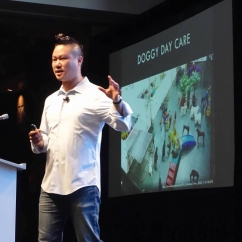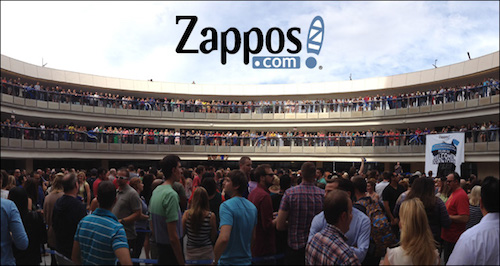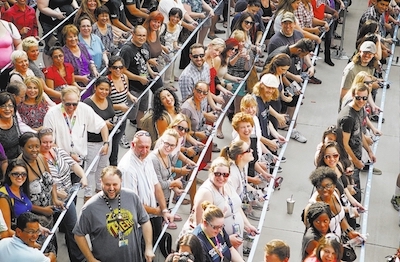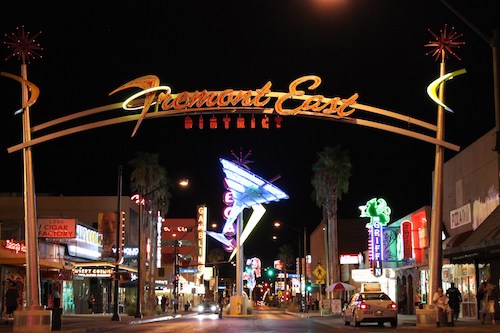Articles and News
Zappos CEO Tells Jewelers Service Has To Be Ingrained In Your Culture March 08, 2017 (0 comments)

Scottsdale, AZ—“When most people think about Zappos, they think of shoes. But internally, we say we are a service company that happens to sell shoes. We spend the money we would have spent on advertising on service instead.”
This, says CEO Tony Hsieh, is how Zappos went from zero revenue in 1999 to over $1 billion in 2008, not even a decade later. All of it, he insists, was word-of-mouth and customer service.
Speaking during the Centurion Scottsdale show (left), Hsieh said that a service-focused company can get into virtually any business where service is a differentiator. As an example, he pointed to Virgin, which started as a music store but now also has an airline. At its heart, Virgin is about customer service, he said.
Service can’t just be lip service—it must be ingrained into the company culture. “If you get that right, your service will be outstanding,” he told the audience. “Whether it’s happy customers or happy employees, it’s about happiness. If there’s only one thing you take away from this talk, take that away.” It’s so important that it was the title of his 2010 book, Delivering Happiness: A Path To Profits, Passion, And Purpose.
“It’s not something we tell customers, it’s something they see when stuff arrives fast and free or they call and encounter someone really cares about service, not just their paycheck. When people get an outfit or a perfect pair of shoes, it’s happiness in a box.”
He also described the company’s move from San Francisco, CA, to Henderson, NV, and ultimately to an older part of downtown Las Vegas. The company, which now has more than 1,500 employees, was spread out over several buildings in Henderson. Although the buildings were only a few minutes’ walk from each other, it still had a negative impact on the company culture, said Hsieh, so about four or five years ago when he found out the City of Las Vegas was going to build a new city hall, he realized the old one would fit Zappos’ needs perfectly.
He started the process of designing the new company headquarters by emailing his employees to see what makes them happy. Of course, he got hundreds of suggestions, from a running track to an onsite gym and pub. “The number one answer of things employees wanted was doggy daycare. It was significantly higher than human daycare!” he said.

Zappos' new headquarters on opening day.
When the ribbon was cut, it was over a mile long and set a world’s record for the most people ever to cut a ribbon. “Someone thought it was a good idea to have a happy hour with 1500 pairs of scissors running around,” he laughed.

1500 Zappos employees cut the ribbon for the opening of its headquarters campus in downtown Las Vegas (Image: Las Vegas Review Journal). Everyone received a special pair of scissors, below. (Image: localadventurer.com)

But some lessons learned during the building process were that while companies build campuses that are great for employees, they’re often not part of the surrounding community.
“What if we could turn that concept inside out, be more analogous to NYU (New York University, in lower Manhattan) where the campus is integral part of the community? What if we throw events where the community comes into the campus and employees go out into the community?”
Zappos is near a neighborhood of Las Vegas called Fremont East, an area most tourists and even many locals don’t know about. Hsieh says it’s the opposite of the Strip: “You go into bars or coffee shops and there’s no gaming. You’d never know you’re in Vegas.” It’s very community-oriented and all the small business owners and residents know each other, but it’s had its challenges and in fact was somewhat dangerous.
Zappos launched what Hsieh called the “Downtown Project,” whose goal was to revitalize the area. By focusing on density to create “collisions” and connections between the company and nearby residents, it fosters what Hsieh calls “co-learning,” or learning about the community and helping it improve itself.
“ROL, or return on luck, is a very real metric. How do we increase luck for people in the community?”
Part of that was becoming an incubator and source of funding for small businesses in the area. $50 million was earmarked by Zappos to help small businesses.
“At the time this began, there were only two or three bars in the area. Unlike a lot of real estate developers, we’re anti- top-down developing. We want a more organic approach,” Hsieh said. He invited people to put sticky notes on his wall, “If your idea of dream neighborhood is not on the wall, write it on sticky note and put it on the wall. If someone has a dream to do a cupcake shop when they retire, why not do it now?” he asked. Essential criteria include that it be a small business, owner-operated, and something that will help the community create more “collisions” and more opportunity.

The Fremont East district of Las Vegas today.
He related the story of a woman named Natalie, whom he met at a local coffee shop and learned she had worked as chef at one of the big casinos on the Strip. Her lifelong dream was to start a breakfast and lunch place, and hers was one of the very first small businesses Zappos funded under the program.
“What’s amazing is she paid back the entire original investment after one year and three months. That’s kind of unheard of in the restaurant industry. It was written in every food magazine and TV show and American Express heard about her story and actually put up a commercial featuring Natalie to an international audience.”
Other restaurant projects followed, as well as a shipping-container park in an empty lot, an early childhood center, and even a music festival. Zappos has hosted many events in the Fremont East area, which isn’t far from its downtown campus. One skateboarding event was live-streamed for customers who are into skateboarding; another event benefited a local zoo about to be shut down; a third focused on collecting and distributing prom dresses to underprivileged teens.
As a result, that section of Las Vegas is starting to attract tech startups with its sense of city and community, Hsieh said. “Our goal is to do for downtown Las Vegas what South By Southwest does for Austin (TX).” Zappos also gives tours of its headquarters campus.
In addition to feeling good, Zappos’ altruism has a little enlightened self-interest in making sure the company remains vibrant, admits Hsieh. Research has shown that every time the size of a city doubles, innovation or productivity per resident increases by 15-20%—but the opposite happens to companies, he said.
“It’s about making sure that doesn’t happen to Zappos. Research on innovation shows that most comes from something outside your industry, not in it. That’s why I want so many entrepreneurs around Zappos and why we need to be organized more like a city and less like a top-down organization.
“A great brand is a story that never stops unfolding. It’s true for brands, companies, cities, and communities. That’s why I’m still so passionate and excited about Zappos. I can’t wait to see what happens next!”







